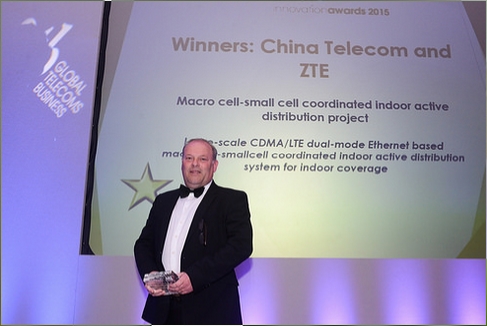13 March 2015, Shenzhen, China – ZTE Corporation (0763.HK / 000063.SZ), a major international provider of telecommunications, enterprise and consumer technology solutions for the Mobile Internet, has today been jointly presented with the Wireless Network Infrastructure Innovation award at the Global Telecoms Business (GTB) Innovation Awards 2015. ZTE and China Telecom won the award for their close collaboration on the Macrocell-Small Cell Coordinated Indoor Active Distribution project.
This award recognised the technological innovations and commercially successful deployment of ZTE’s Qcell solution, an innovative, digital, and active indoor coverage solution. GTB, as an authoritative body specialised in the international telecommunications industry, founded the GTB Innovation Awards to honour globally innovative telecommunications projects and services.
According to statistics, 70 percent of wireless data services occur indoors. In the early stages of LTE (long-term evolution) deployment, China Telecom realised the importance and value of high-quality indoor coverage. When it comes to indoor 4G coverage, traditional DAS (distributed antenna system) has many constraints, which includes difficult MIMO (multiple input multiple output) upgrades, long construction periods and inflexible capacity adjustments. ZTE’s Qcell solution comfortably satisfies China Telecom’s existing indoor LTE coverage requirements.
The Qcell solution can simultaneously support multiple frequency bands and multiple modes such as TD-LTE (time division-long term evolution), FDD LTE (frequency division duplex-long term evolution), UMTS (Universal Mobile Telecommunications System), and CDMA (Code Division Multiple Access). The Qcell solution includes a picoRRU (remote radio unit), P-bridge and BBU (baseband unit). The picolRRU is the world's smallest multiband and multimode picoRRU, which adopts standard CAT5E/6 Ethernet cables for connection to P-bridge and power supply. Optical fibres are used between the BBU and the P-bridge for sharing baseband resources among multiple cells. The Qcell system can share the same network management system with traditional macrocells. Such simplified network architecture not only reduces engineering complexity and deployment and maintenance cost, but also saves 60 percent of the deployment time.
A relevant technical expert of China Telecom believes that heterogeneous network architecture and deployment where coordination between small cells and macrocells is involved will help fulfil 4G network coverage and capacity requirements, and greatly improve the user experience. With ZTE’s Qcell solution, such network architecture can be properly implemented. China Telecom will continue to drive innovation of this technology, and will collaborate with ZTE in continuous exploration into the commercial deployment of such mixed networks.
Qcell is the world's first multi-frequency 2G/3G/4G digital indoor coverage system, and has been officially launched in the Sichuan branch of China Telecom. Feng Jie, deputy general manager of the Sichuan branch, China Telecom said, "While exploring and constructing next-generation, multi-mode, and multi-frequency indoor coverage networks in the mobile Internet era, ZTE and China Telecom have worked together on product analysis, solution reasoning, field verification tests and pilot runs. This has occurred in a 300,000 square metre area including office buildings, shopping malls, campuses, hotels, and other areas that replicate other typical barriers to network coverage. As a result, both companies have accumulated extensive experience and achieved remarkable success in this area."
Zhang Jianguo, Vice President ZTE, said, "The ZTE Qcell solution has been successfully deployed in China Telecom’s digital indoor coverage system, where coordination between macrocells and small cells is involved. This demonstrates ZTE’s understanding of operator needs and the innovation strength of macrocell andsmall cell coordination, as well as deep indoor 4G network coverage. ZTE will continue to promote in-depth cooperation with operators, drive the application of its Qcell solution, and devote itself wholly to providing a more flexible and effective in-depth indoor coverage solution."
